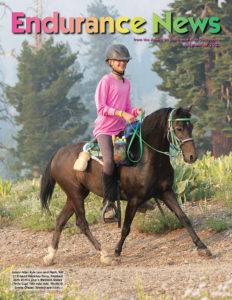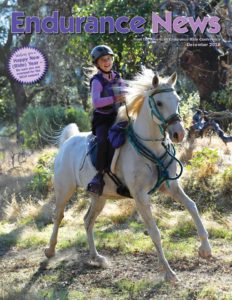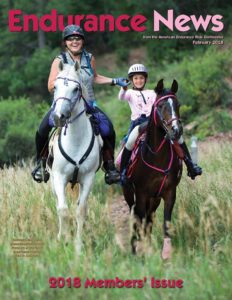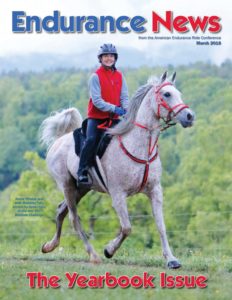Junior riders who would like to contact someone knowledgeable about junior endurance riding are welcome to contact a member of the Junior Committee (see Committee Page).
Questions and Answers for Junior Riders
By Alina Vale
Q. At what age am I no longer a junior?
A. If you are not yet 16 at the beginning of the ride season, then you are still a junior for the rest of that ride season. The official AERC ride season begins on December 1 and ends on November 30 of each year. However, juniors that are 14 years old and have accumulated at least 500 miles can request permission from AERC to ride in the senior division.
Q. Who can sponsor me?
A. A sponsor is a rider 18 years or older who agrees to stay with the junior at all times during the ride — including entering and leaving all vet checks at the same time — and not be more than one minute apart at the finish. If your sponsor is pulled at a vet check, you will notify ride management and get a new sponsor. A good sponsor is fun to ride with, is familiar with the trail, knows the junior and their horse’s limitations, and can educate the junior about the sport and proper horse care.
Q. What should I wear and what kind of tack should I use?
A. Comfort for horse and rider is the most important factor for determining what clothing and tack to use for an endurance ride. Stretchy riding tights, jeans, chaps, and shorts can be seen at rides. You could wear boots with heels, or running shoes if you want to get off and jog with your horse.
Layers of shirts and jackets will be important depending on the location and time of year. All juniors must wear an approved helmet! Some riders also wear gloves or a waist pack.
The horse can be outfitted in any English, western, or endurance-type saddle that fits correctly. Many types of saddle pads, girths, breast collars, cruppers, bridles, bits, martingales, splint boots, and saddle packs are available.
Make sure all your tack is adjusted properly and in good repair, and avoid using anything for the first time at an endurance ride.
Q. What kind of horse can do an endurance ride?
A. While any breed of horse or mule may compete in an endurance ride, Arabian and half-Arabians are by far the most common. Many Thoroughbreds, Mustangs, gaited horses, mules and Icelandics, and many other breeds, that have done well also.
Horses must be 48 months old to do a limited distance ride, 60 months old to do a 50-mile endurance ride, and 72 months old to do a 100-mile endurance ride. It is important to start with a healthy and sound horse and follow a proper conditioning schedule to build your horse up to an endurance ride.
Q. Do I have to have my own horse?
A. While most endurance riders compete on their own horses, some people have extra horses available. If you demonstrate you are a proficient rider and will take great care of the horse, and can help with conditioning rides on the weekends, you might be able to compete on someone else’s horse.
Q. How much time do you have to finish?
A. The normal cutoff time for a 25-mile ride is six hours, in a 50-mile ride you have 12 hours, and a 100-mile ride must be done in less than 24 hours. Exact maximum ride times are listed under Appendix A at the back of the AERC Rules and Regulations booklet.
Q. Is endurance riding hard on horses?
A. Endurance riding can be demanding, and horses are pulled from the competition if they display any signs of lameness or metabolic problems. Most riders care very deeply about their horses and will sacrifice one ride so they can continue to compete on their horse in the future. Some of the top endurance horses have thousands and thousands of miles under their belt, and are still going strong.
Q. How does the ride start?
A. An endurance ride start can be quite exciting and scary depending on how many riders there are. Many rides have “shotgun starts” where everyone can take off at their own speed. Some rides have controlled starts where riders must stay behind a designated point rider, who may be instructed to trot for the first mile before letting everyone loose. It is often a good idea to start after the large pack at your first ride as you don’t know how your horse will react.
Q. What are the courses like?
A. Depending on the location, the ride might include forests, sandy beaches, mountains, deserts, and other types of terrain. Trails can be single-track, jeep roads, mountain paths, dry river beds, and sometimes manicured bridle paths. Some rides are flat, some rocky, or technical and steep with switchbacks — make sure to enquire beforehand so you and your horse are well prepared and safe. The course is marked (often with ribbon attached to clothespins on trees) and you should be given a map.
Q. Why should I do endurance riding?
A. Because it is fun for you and your horse! It is great conditioning and training for other events that you participate in. Your mount won’t tire out in that demanding cross-country phase of a three-day, and won’t think of spooking at the obstacles in a trail course anymore.
You will become a better rider and learn many ways to take care of your horse. You will earn great prizes in the junior division for completing each ride and accumulate points and miles for year-end awards. And you will get to meet other great juniors in the sport!
We hope to see you on the trail.





